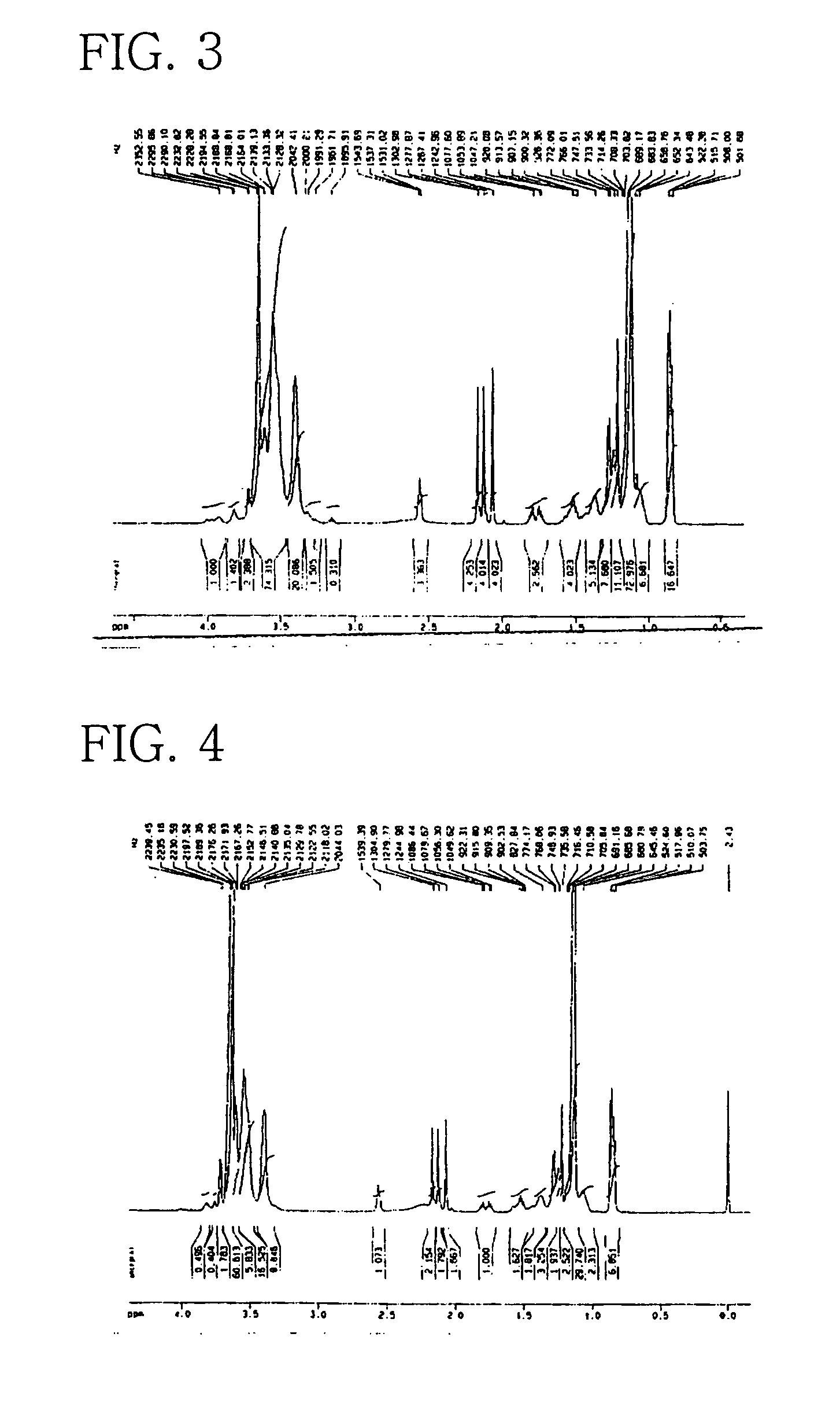Polyoxyethylene-polyoxypropylene vitamin E and process for preparation thereof
- Summary
- Abstract
- Description
- Claims
- Application Information
AI Technical Summary
Benefits of technology
Problems solved by technology
Method used
Image
Examples
example 1
Preparation of POE(20 EO)-POP(10 PO) Vitamin E (1)
[0057]In a 2 L double stainless steel autoclave were introduced 125 g (0.29 mol) of synthetic vitamin E (d1 α-tocopherol) and then, 0.15 g of highly pure methoxy sodium (CH3ONa). The reactor was demoisturized by heating to 78° C. under vacuum of about 750 mmHg for about 30 min. Thereafter, 170 g (2.93 mol) of PO was added to the reactor under pressure and allowed to react at 155–160° C. for about 7 hours, so as to give a liquid phase of POP vitamin E. After being further added with 0.1 g of methoxy sodium, the liquid was subjected to addition reaction with 265 g (6.02 mol) of EO over a period of 7 hours at 160–165° C. with stirring.
[0058]After completion of the reaction, the reactor was purged three times with gaseous nitrogen to remove unreacted PO and EO and the by-product 1,4-dioxane. The reaction mixture was cooled to about 50° C., followed by adding a trace amount of citric acid to neutralize the alkaline catalyst. After unreact...
example 2
Preparation of POE(5 EO)-POP(20 PO) Vitamin E (2)
[0069]In a 2 L double stainless steel autoclave were introduced 125 g (0.29 mol) of synthetic vitamin E (d1 α-tocopherol) and then, 0.1 g of highly pure potassium hydroxide (99.9%). The reactor was demoisturized by heating to 76° C. under vacuum of about 755 mmHg for about 30 min. Thereafter, 345 g (5.95 mol) of PO was added to the reactor under pressure and allowed to react at 160–165° C. for about 6 hours with stirring, so as to give a liquid phase of POP vitamin E. After being further added with 0.08 g of potassium hydroxide (99.9%), the liquid was subjected to addition reaction with 65 g (1.48 mol) of EO over a period of 8 hours at 165–170° C. to afford POE-POP vitamin as yellow liquid.
[0070]After completion of the reaction, the reactor was purged three times with gaseous nitrogen to remove unreacted PO and EO and the by-product 1,4-dioxane. The reaction mixture was cooled to about 60° C., followed by adding a trace amount of hydr...
example 3
Preparation of POE(30EO)-POP(20PO) Vitamin E (3)
[0082]In a 2L double stainless steel autoclave were introduced 112 g (0.26 mol) of synthetic vitamin E (d1 α-tocopherol) and then, 0.12 g of highly pure methoxy sodium. The moisture inside the reactor was removed by heating to 76° C. under vacuum of about 750 mmHg for about 30 min. Thereafter, 310 g (5.34 mol) of PO was added to the reactor under pressure and allowed to react at 160–165° C. for about 6 hours with stirring, so as to give a liquid phase of POP vitamin E. This liquid was subjected to addition reaction with 350 g (7.95 mol) of EO over a period of 8 hours at 160–165° C. in the presence of 0.10 g of methoxy sodium to give a yellow liquid phase.
[0083]After completion of the reaction, the reactor was purged three times with gaseous nitrogen to remove unreacted PO and EO and the by-product 1,4-dioxane. The reaction mixture was cooled to about 60° C., followed by adding a trace amount of hydrochloric acid to neutralize the alkal...
PUM
| Property | Measurement | Unit |
|---|---|---|
| Temperature | aaaaa | aaaaa |
| Percent by mass | aaaaa | aaaaa |
| Volume | aaaaa | aaaaa |
Abstract
Description
Claims
Application Information
 Login to View More
Login to View More - R&D Engineer
- R&D Manager
- IP Professional
- Industry Leading Data Capabilities
- Powerful AI technology
- Patent DNA Extraction
Browse by: Latest US Patents, China's latest patents, Technical Efficacy Thesaurus, Application Domain, Technology Topic, Popular Technical Reports.
© 2024 PatSnap. All rights reserved.Legal|Privacy policy|Modern Slavery Act Transparency Statement|Sitemap|About US| Contact US: help@patsnap.com










